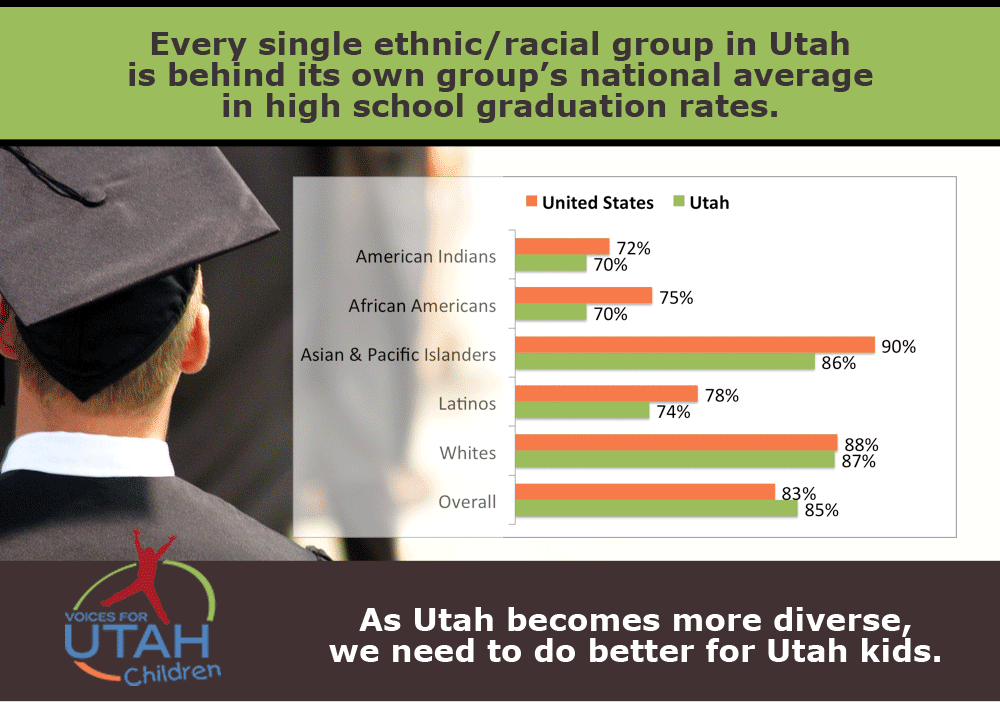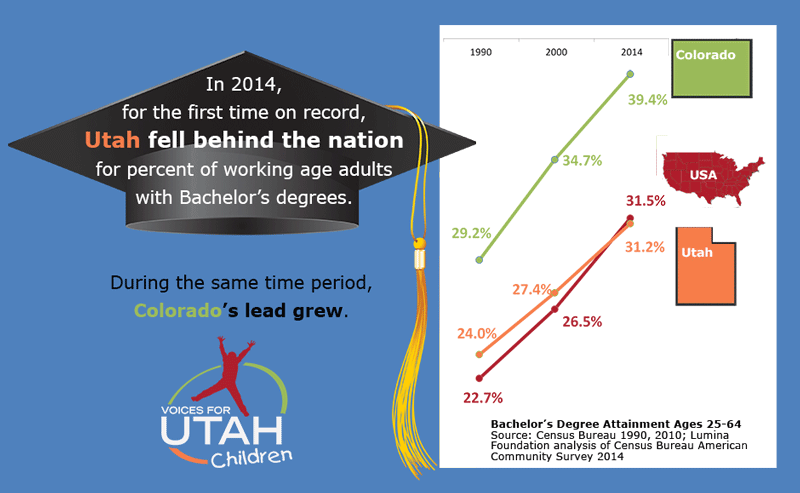This op-ed by Voices for Utah Children State Priorities Partnership Director Matthew Weinstein originally appeared in the Salt Lake Tribune on October 29, 2016.
This month saw the publication of new state and federal data on high school graduation rates for the 2014-15 school year. "Utah high school graduation rate above average: 84.8 percent" crowed the headline of the Associated Press coverage carried in many Utah newspapers. But a closer look at the data reveals a more troubling picture.
 For the nation as a whole, high school graduation rates have been rising steadily in recent years. When broken out by race and ethnicity, the data show progress across the board, but also substantial disparities.
For the nation as a whole, high school graduation rates have been rising steadily in recent years. When broken out by race and ethnicity, the data show progress across the board, but also substantial disparities.
Here are the data for U.S. high school graduation rates in 2015: U.S. overall, 83.2 percent; whites, 87.6 percent; Latinos, 77.8 percent; Asian Americans/Pacific Islanders, 90.2 percent; African Americans, 74.6 percent; American Indians, 71.6 percent.
And here are the equivalent data for Utah in 2015: Utah overall, 84.8 percent; whites, 87.4 percent; Latinos 74.4 percent, Asian Americans/Pacific Islanders, 86.0 percent; African Americans, 70.0 percent; American Indians, 70.0 percent.
Two things stand out about these data:
1) Utah is ahead of the national average in the overall high school graduation rate.
2) Every single ethnic/racial group in Utah is behind its own group's national average, including our two largest populations, whites and Hispanics.
How is it possible that we are ahead of the national average overall but behind within each individual ethnic/racial group? The answer is simple math: we have a higher-than-average share of whites, who have a higher than average high school graduation rate. Utah's population is 79 percent non-Hispanic white, while the national average is 62 percent.
But should we be concerned that every racial/ethnic group in Utah is behind the national graduation rates for its own group? We should, for several reasons:
1) Regarding our white majority, these data should prompt us to ask: Why has the white population in Utah over the last few years been 0.2-0.6 points behind whites nationally? Could it be that even Utah's highest-in-the-nation level of two-parent families and high levels of parent volunteerism are not enough to overcome the detrimental effects of our lowest-in-the-nation level of per-pupil funding, even among the most economically secure segment of our population?
2) Our Hispanic minority is growing fast — now reaching 14 percent of the state's population — and 17 percent of our children. This means that Latinos are one-sixth of our future workforce. The fact that their graduation rate is 10.4 points behind the state average — and 3.4 points behind Latinos nationally — should be cause for very great concern.
3) Our two smallest minorities, African Americans and American Indians, together make up 3 percent of our population and fall 15 percentage points behind the state average for high school graduation rates, our largest disparity.
 These alarming findings come just a few months after it was reported that Utah has now, for the first time on record, fallen behind the national average for college degrees (bachelor's degrees and higher among our working-age population ages 25-64). Taken together, these new data show Utah underperforming at both the high school and college levels, seriously weakening the case made by those who argue that new revenues are unnecessary because we achieve good results in spite of low investment.
These alarming findings come just a few months after it was reported that Utah has now, for the first time on record, fallen behind the national average for college degrees (bachelor's degrees and higher among our working-age population ages 25-64). Taken together, these new data show Utah underperforming at both the high school and college levels, seriously weakening the case made by those who argue that new revenues are unnecessary because we achieve good results in spite of low investment.
Following a decade of tax cutting, Utah's overall tax burden (including all state and local taxes and fees) is at a multi-decade low. Utah's sub-par educational performance raises an important question about whether the current generation of Utahns is doing its part, as earlier generations did, to set aside sufficient resources to invest in our children and lay the foundations for our future growth and prosperity. While raising taxes is rarely popular, any mom or dad will tell you that sometimes you have to eat your broccoli, whether you like it or not.
 On the topic of low investment, this month also saw the release of a new national report that found Utah ranks sixth worst in the nation for our drop in per-pupil state formula funding for K-12 education — down 11.9 percent from FY 2008 to 2017 (the current fiscal year). This 11.9 percent drop measures just the state contribution that constitutes two-thirds of our total public education budget. But the picture is no better when we look at the older data that include both state and local funding, which showed us seventh worst in the nation with a 17 percent drop in per-pupil expenditure for 2008-2014.
On the topic of low investment, this month also saw the release of a new national report that found Utah ranks sixth worst in the nation for our drop in per-pupil state formula funding for K-12 education — down 11.9 percent from FY 2008 to 2017 (the current fiscal year). This 11.9 percent drop measures just the state contribution that constitutes two-thirds of our total public education budget. But the picture is no better when we look at the older data that include both state and local funding, which showed us seventh worst in the nation with a 17 percent drop in per-pupil expenditure for 2008-2014.
Opponents of new education revenues have for years counseled patience. They have for years assured us that the economic boom that will generate new public education revenues is just around the corner or perhaps just another tax cut away. How long will we wait and watch our educational performance suffer — endangering our future prosperity — before taking seriously the challenge before us?
For 30 years now, Voices for Utah Children has called on our state, federal and local leaders to put children’s needs first. But the work is not done. The children of 30 years ago now have children of their own. Too many of these children are growing up in poverty, without access to healthcare or quality educational opportunities.
How can you be involved?
Make a tax-deductible donation to Voices for Utah Children—or join our Network with a monthly donation of $20 or more. Network membership includes complimentary admission to Network events with food, socializing, and opportunity to meet child advocacy experts. And don't forget to join our listserv to stay informed!
We look forward to the future of Voices for Utah Children and we hope you will be a part of our next 30 years.
Special thanks to American Express, our "Making a Difference All Year Long" sponsor. 






